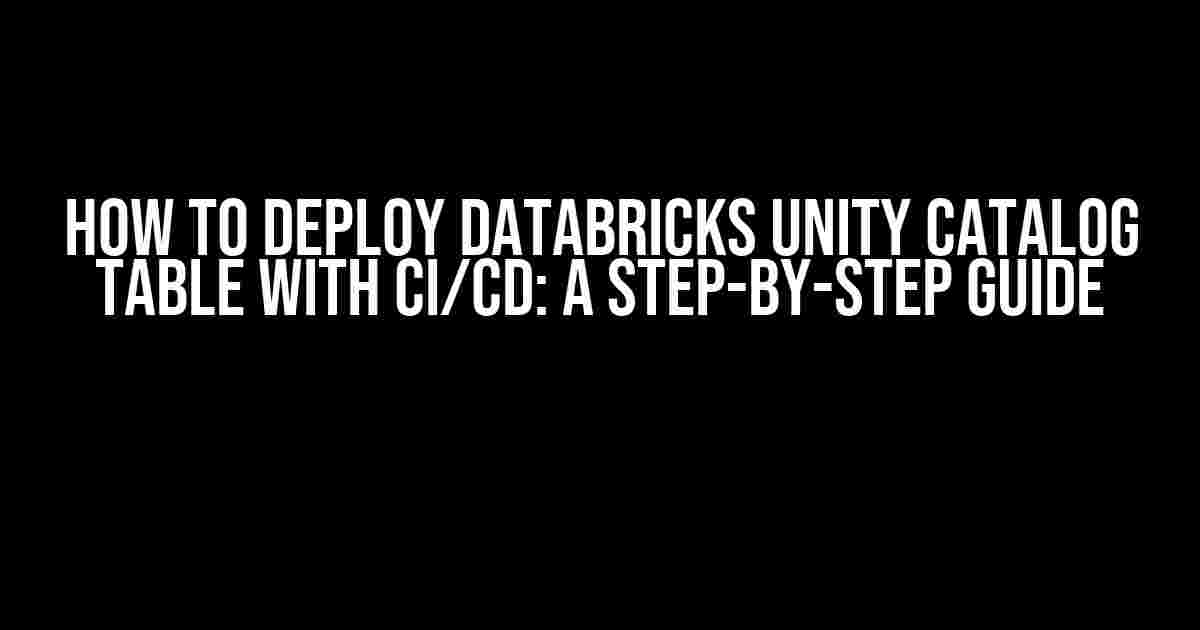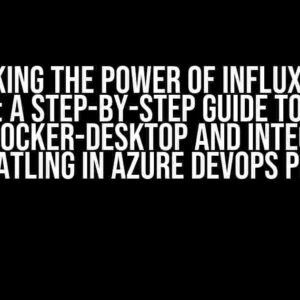Are you tired of manually deploying your Databricks Unity Catalog tables, only to find that they’re not up-to-date or worse, broken? Do you want to streamline your deployment process and ensure that your tables are always in sync with your code changes? Look no further! In this article, we’ll show you how to deploy Databricks Unity Catalog tables with CI/CD, so you can focus on what matters most – building amazing data products.
What is Databricks Unity Catalog?
Before we dive into the deployment process, let’s quickly cover what Databricks Unity Catalog is. Unity Catalog is a centralized metadata management system in Databricks that allows you to manage and share datasets, tables, and models across your organization. It provides a single source of truth for your data assets, making it easier to collaborate, version, and reproduce your work.
Why Deploy Databricks Unity Catalog Tables with CI/CD?
Deploying your Unity Catalog tables with CI/CD offers several benefits, including:
- Consistency: Ensure that your tables are always up-to-date and consistent across environments.
- Automation: Automate the deployment process, reducing the risk of human error and freeing up your time.
- Version Control: Track changes to your tables and roll back to previous versions if needed.
- Collaboration: Enable collaboration among team members and stakeholders by providing a single source of truth.
Prerequisites
Before we begin, make sure you have:
- A Databricks workspace with Unity Catalog enabled.
- A code repository (e.g., GitHub, GitLab) for your table definitions.
- A CI/CD tool (e.g., Jenkins, GitHub Actions) set up and configured.
Step 1: Define Your Table in a Code Repository
Create a new file in your code repository (e.g., `tables/my_table.json`) with the following contents:
{
"name": "my_table",
"description": "My awesome table",
"columns": [
{
"name": "id",
"dataType": "integer"
},
{
"name": "name",
"dataType": "string"
}
]
}
This file defines a simple table with two columns: `id` and `name`. You can add more columns, data types, and other properties as needed.
Step 2: Create a Databricks Unity Catalog API Token
Log in to your Databricks workspace and navigate to the Unity Catalog page. Click on your profile picture in the top right corner and select “API Tokens” from the dropdown menu. Create a new API token with the ” Unity Catalog” scope.
Save the API token securely in a secrets manager or environment variable. We’ll use it later to authenticate with the Unity Catalog API.
Step 3: Configure Your CI/CD Tool
Set up a new CI/CD pipeline in your chosen tool (e.g., Jenkins, GitHub Actions) with the following steps:
Step 3.1: Checkout Code
Checkout your code repository containing the table definition file.
Step 3.2: Install Databricks Unity Catalog CLI
Install the Databricks Unity Catalog CLI using pip:
pip install databricks-unity-catalog
Step 3.3: Authenticate with Unity Catalog API
Set the Unity Catalog API token as an environment variable:
export UNITY_CATALOG_API_TOKEN=<your_api_token>
Step 3.4: Deploy Table
Use the Unity Catalog CLI to deploy your table:
databricks unity-catalog tables deploy --token $UNITY_CATALOG_API_TOKEN --file tables/my_table.json
This command deploys the `my_table.json` file to the Unity Catalog, creating a new table or updating an existing one.
Step 3.5: Verify Deployment
Verify that the table has been deployed successfully:
databricks unity-catalog tables get --token $UNITY_CATALOG_API_TOKEN --name my_table
This command retrieves the table definition from the Unity Catalog, ensuring that it matches your code repository.
Step 4: Configure Automated Deployment
Configure your CI/CD tool to trigger the pipeline automatically on code changes:
For example, in GitHub Actions, add a webhook to trigger the pipeline on push events:
on:
push:
branches:
- main
jobs:
deploy:
runs-on: ubuntu-latest
steps:
- name: Checkout code
uses: actions/checkout@v2
- name: Install Unity Catalog CLI
run: pip install databricks-unity-catalog
- name: Deploy table
env:
UNITY_CATALOG_API_TOKEN: ${{ secrets.UNITY_CATALOG_API_TOKEN }}
run: databricks unity-catalog tables deploy --token $UNITY_CATALOG_API_TOKEN --file tables/my_table.json
- name: Verify deployment
run: databricks unity-catalog tables get --token $UNITY_CATALOG_API_TOKEN --name my_table
In Jenkins, configure a webhook to trigger the pipeline on push events:
pipeline {
agent any
triggers {
webhook {
url 'https://your-jenkins-instance.com/github-webhook/'
}
}
stages {
stage('Deploy') {
steps {
sh 'pip install databricks-unity-catalog'
sh 'databricks unity-catalog tables deploy --token $UNITY_CATALOG_API_TOKEN --file tables/my_table.json'
sh 'databricks unity-catalog tables get --token $UNITY_CATALOG_API_TOKEN --name my_table'
}
}
}
}
Conclusion
That’s it! You’ve successfully deployed your Databricks Unity Catalog table with CI/CD. From now on, any changes to your table definition will be automatically deployed to your Unity Catalog, ensuring consistency and version control across your organization.
Remember to test your pipeline thoroughly and adapt it to your specific use case. Happy deploying!
| Step | Description |
|---|---|
| 1 | Define your table in a code repository |
| 2 | Create a Databricks Unity Catalog API token |
| 3 | Configure your CI/CD tool |
| 4 | Configure automated deployment |
FAQs
Q: What if I have multiple tables to deploy?
A: You can deploy multiple tables by creating a separate pipeline step for each table or by using a wildcard in your pipeline script to deploy all tables in a specific directory.
Q: How do I handle errors during deployment?
A: You can use try-catch blocks in your pipeline script to handle errors during deployment. For example, you can catch exceptions and send notifications to your team or stakeholders.
Q: Can I use this approach for other Databricks assets, such as models and datasets?
A: Yes, you can adapt this approach to deploy other Databricks assets, such as models and datasets, by using the corresponding Unity Catalog CLI commands.
By following these steps, you’ll be able to deploy your Databricks Unity Catalog tables with CI/CD, ensuring that your data assets are always up-to-date and consistent across your organization. Happy deploying!
Here are the 5 Questions and Answers about “How to deploy Databricks Unity Catalog table with CI/CD”:
Frequently Asked Questions
Get ready to unleash the power of Databricks Unity Catalog with CI/CD deployment! Here are the top questions and answers to get you started.
What is the first step in deploying a Databricks Unity Catalog table with CI/CD?
The first step is to create a Databricks Unity Catalog table and ensure it’s correctly configured for CI/CD deployment. This includes defining the table schema, setting up the right permissions, and configuring the deployment credentials.
How do I automate the deployment of my Databricks Unity Catalog table with CI/CD?
You can automate the deployment of your Databricks Unity Catalog table using CI/CD tools like Azure DevOps, GitHub Actions, or Jenkins. These tools allow you to create pipelines that can deploy your table to different environments, such as dev, staging, and prod, with just a few clicks.
What is the role of Databricks API in deploying Unity Catalog tables with CI/CD?
The Databricks API plays a crucial role in deploying Unity Catalog tables with CI/CD. It provides a programmatic way to interact with Databricks, allowing you to automate tasks like creating, updating, and deploying tables. You can use the API to create scripts that can be executed as part of your CI/CD pipeline.
How do I handle dependencies between different tables in my Databricks Unity Catalog?
To handle dependencies between different tables in your Databricks Unity Catalog, you can use the `dependsOn` clause in your table creation scripts. This allows you to specify the order in which tables should be created and deployed, ensuring that dependent tables are created only after their dependencies are met.
What are the best practices for testing and validating my Databricks Unity Catalog tables in a CI/CD pipeline?
To ensure the quality of your Databricks Unity Catalog tables, it’s essential to test and validate them in your CI/CD pipeline. Best practices include writing unit tests for your table creation scripts, using data validation frameworks like Great Expectations, and performing integration tests to ensure that your tables work as expected in different environments.
I hope this helps! Let me know if you have any further requests.




